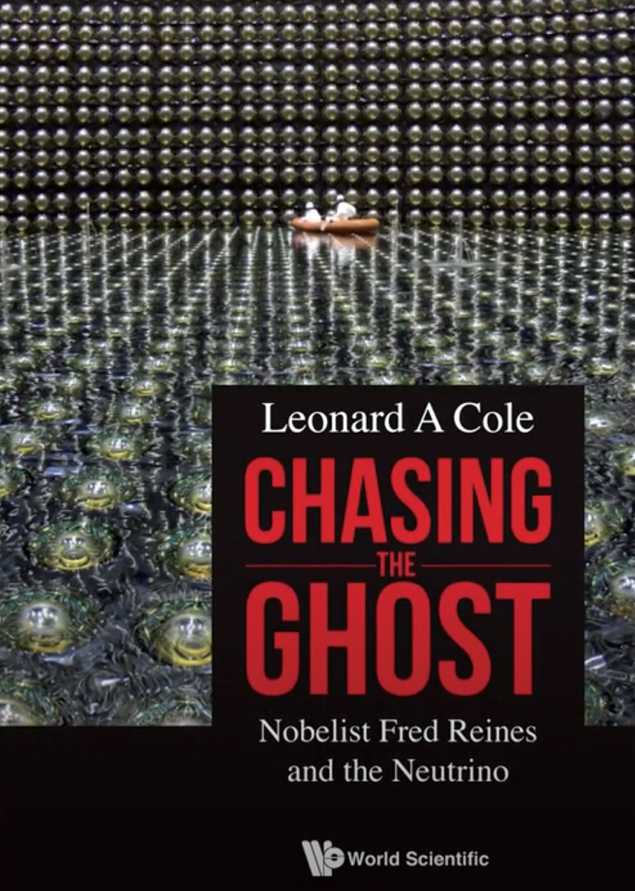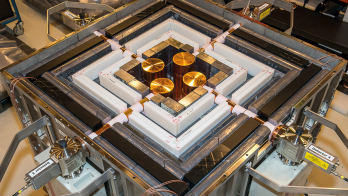Chasing the Ghost, by Leonard A Cole, World Scientific

Every Nobel Prize comes with a story, and Leonard A Cole’s Chasing the Ghost offers a new perspective on that of Fred Reines, best known for discovering the electron neutrino with Clyde Cowan in 1956. While Cowan passed away in 1974, Reines went on to win the Nobel Prize in Physics for their discovery in 1995. Cole, Reines’s cousin, describes the life of Fred Reines – focusing on both his scientific career and extracurricular interests – in a personal way, showing obvious admiration for his elder cousin.
After participating in the Manhattan Project and assisting in developing nuclear weapons in the 1940s, Reines pivoted to study neutrinos, the fundamental particles emitted in nearly every nuclear reaction, which he describes as “the tiniest quantity of reality ever imagined by a human being”. While being tiny quantities, neutrinos are abundant, yet mysterious, and Reines’s work opened the door to better understand these particles. His research spanned the next five decades, and positions at universities and laboratories across the US, and the techniques that he developed to study neutrinos are used to this day.
Rainbows and Things
Throughout Chasing the Ghost, Cole splits his time between describing Reines’s career and his extracurricular pursuits. Even among his colleagues, Reines was known to be a prolific singer, performing with groups including the Los Alamos Light Opera Association and the Cleveland Orchestra Chorus. Time spent pondering these activities allowed Reines to connect better with non-science-major students when lecturing at universities. Reines famously taught his course “Rainbows and Things” to much acclaim at the University of California, Irvine, where he encouraged students to think deeply about the connection between classroom physics and the natural world. Cole explains that the course name, and much of its philosophy, stems from the play Finian’s Rainbow, which Reines performed in 1955.
Throughout his later life, it became apparent that Reines thought his accomplishments deserved more praise than they had received. In fact, it was only after he gave up hope of winning the Nobel Prize that he won it in 1995. Reines had been passed up on many occasions, including in 1988 when the team that discovered the second type of neutrinos was awarded the prize before him. Cole shares a humorous anecdote (in hindsight): at a CERN conference with both Reines and 1988 laureate Leon Lederman in attendance, a speaker suggested an experiment to search for the third type of neutrino, the tau neutrino. However, as the speaker lamented, it seemed as if no one would perform this type of experiment, “because evidently they only give a Nobel Prize for the detection of every other neutrino.” While the room may have burst into laughter, Fred Reines didn’t budge.

Regardless, Reines’s dedication to understand neutrinos persisted until the end of his life. Shortly before passing, when he heard of the ground-breaking news from Super-Kamiokande that neutrinos oscillate, he astutely asked “What’s the mass?”, understanding the implications of this result.
The work spearheaded by Reines and his contemporaries has made a lasting impact on the field of particle physics, that continues today. As Cole explains, the subfield of neutrino physics has blossomed to include large, international experimental collaborations, which have found even more unexpected results. Those results have spurred investigators to plan ambitious projects, such as the IceCube experiment in Antarctica, the DUNE experiment in the US, and Hyper-Kamiokande in Japan.
Inspiration
Today’s neutrino detectors are getting bigger and bigger. However, their forerunners can still serve a purpose: inspiration. Several detectors from Reines’s era are now exhibited, such as the Gargamelle detector at CERN. After discovering the electron neutrino, the race was on to build experiments to better understand neutrino properties, and Gargamelle was one such detector. Today, it is on display at the CERN Microcosm, perhaps inspiring a new generation of neutrino physicists.
Overall, Leonard A Cole’s Chasing the Ghost will inspire readers, especially those new to thinking about neutrino physics. Fred Reines’s work, with its focus on a deep understanding of these mysterious, abundant particles, continues to bear fruit to this day. There is no telling what the next neutrino experiments will uncover, but it’s a guarantee that sharp thinkers like Reines will be necessary in this field in the generations to come.








